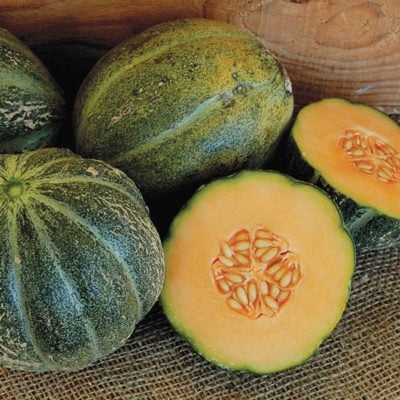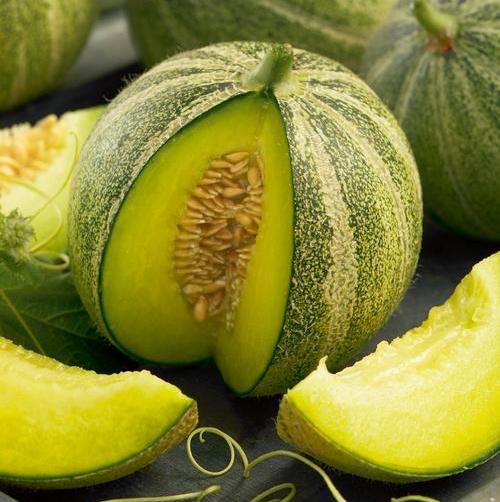
Learning Download: How to Grow Melons
From Seed to Harvest: A guide to growing melons.
Melons provide a sweet and colorful addition to summer meals, and they can be grown in the home garden. In addition to the typical cantaloupe and honeydew melons, gardeners can grow other varieties such as banana melons.
To plant:
Melons are a warm-weather crop and do well in southern climates. Plant seeds in raised rows, as it encourages good drainage. In cooler climates, begin seeds indoors a month before transplanting. Transplant to the garden once all danger of frost has passed. If sowing directly outdoors, plant 1 inch deep and 18 inches apart in hills set 3 feet apart.
To grow:
Cover with floating row covers to discourage insects. Once flowers begin to appear, remove the covers. Melons need a steady supply of water, and soil needs to be damped but not flooded, approximately 1 inch a week. Apply mulch, grass clippings or straw around the plants. Use methods to discourage fungus on leaves, as the leaves are the source of creating sugar for sweeter melons.
To harvest:
A week prior to harvesting, wean off watering as water dilutes the sugar in the plant. A ripe melon should be very easy to remove from the vine. For a cantaloupe, the netting pattern on the melon becomes more visible and a crack appears at the base of the stem when it was ripe. For a honeydew, the color becomes creamy.
What melons crave:
Prior to planting, mix aged manure and compost into the soil. Melons are heavy feeders, so fertilize at panting and throughout the growing season with a 5-5-5 or 10-10-10 granular fertilizer. Do not let the granules come in contact with the plant.
Where to buy melon seeds:
You can find many different kinds of melon seeds, including cantaloupe, honeydew and more at Urban Farmer.
Learning Download: Common pests and diseases: Melons
Common pests and diseases: Melons
When growing vegetables, it is always exciting to care for the plant throughout its growing phase and then harvest it for delicious recipes later on, but one thing to watch out for is pests and diseases. Different plants are susceptible to different types of pests and diseases, and it is important to make yourself aware so you can keep a watchful eye and also take any preventative methods to keep your plants safe throughout their lifespan.
Melons can fall victim to several different pests and diseases.
Pests:
Insects affecting melon plants include aphids, squash beetles, pickleworms and cucumber beetles.
Aphids are soft-bodied insects that bring problems to lots of plants. They create discoloration of the leaves, necrotic spots and stunted growth. Use tolerant varieties and only apply insecticides if there’s a high infestation.
Squash beetles affect all sorts of cucurbits and will feed on the leaves of the plant. It can overwinter in crop debris. To manage this insect, use pyrethrin or neem oil extract.
Pickleworms are damaging to several types of cucurbits, but when it comes to melons, it most commonly affects cantaloupes and watermelons. The caterpillars will tunnel into the flower, buds, stems or fruit of the plant. When a fruit has been damaged, it is not edible, and sometimes, the damage isn’t noticed until the fruit is cut open. To prevent this, plant as early as possible in the season and destroy damaged fruit. To treat this insect, use applications of Bacillus thuringiensis, pyrethrin, neem oil extract or Spinosad.
Cucumber beetles are spotted yellow beetles that cause stunted seedlings and damaged leaves, as well as plants exhibiting signs of bacterials wilt and scars the melons. These beetles will overwinter in the soil. To prevent them, use floating row covers, apply kaolin clay and if necessary, use an insecticide.
Diseases:
Some of the most common diseases affecting melons, specifically watermelons, include anthracnose, Alternaria leaf spot, powdery mildew and more.
Anthracnose will cause small, dark spots on crown leaves after the vines begin to run. This disease can be seedborne and it can affect all but the youngest leaves. Treat seeds, practice crop rotation and utilize the appropriate fungicides to prevent this disease.
Alternaria leaf spot causes round or irregular lesion on older leaves. This disease prefers wet conditions, and it is a fungus. It can be controlled by practicing crop rotation, destroying all crop debris after harvest and applying the appropriate fungicides.
Powdery mildew is also a fungus affecting melons, and it causes a white or gray dusty material on the upper surface of the leaves. It spreads to cover the entire leaf, which then kills the leaf. This disease prefers high humidity, and it is best treated by applying the appropriate fungicides as soon as you notice a problem. This disease usually occurs on older leaves first, and it typically appears later on in the growing season.
Learning Download: Melon Comparison Chart
Melon Comparison Chart
| Type | Variety | Days to Maturity | Shape | Color | Netting/Ribbing | Weight | Disease Resistance |
| Canary | Juane Canary** | 90-110 | Oval | Yellow skin, Light yellow flesh | Heavily wrinkled | 4-5 pounds | |
| Cantaloupe (Muskmelon) | Ambrosia Hybrid | 86 | Round | Green skin, Orange flesh | Heavily netted | 4-6 pounds | Downy Mildew, Powdery Mildew |
| Cantaloupe (Muskmelon) | Banana** | 90 | Oval | Yellow skin, Yellow/Orange flesh | Smooth | 5-7 pounds | |
| Cantaloupe (Muskmelon) | Delicious 51** | 85 | Round | Buff skin, Orange flesh | Heavily netted | 2-3 pounds | Fusarium Wilt, Powdery Mildew |
| Cantaloupe (Muskmelon) | Edisto 47** | 90 | Round | Buff skin, Orange flesh | Heavily netted | 4-6 pounds | Anthracnose, Downy Mildew, Powdery Mildew |
| Cantaloupe (Muskmelon) | Hales Best Jumbo** | 85 | Oval | Green/Buff skin, Orange flesh | Heavily netted | 4-6 pounds | |
| Cantaloupe (Muskmelon) | Hearts of Gold** | 90 | Round | Green/Buff skin, Yellow/Orange flesh | Heavily netted | 2-3 pounds | |
| Cantaloupe (Muskmelon) | Honey Rock*** | 80 | Round/Oval | Buff with green striped skin, Orange flesh | Slightly ribbed and netted | 3-4 pounds | Fusarium Wilt |
| Cantaloupe (Muskmelon) | Minnesota Midget** | 75 | Round | Green/Yellow skin, Orange flesh | Slightly ribbed and netted | 1-2 pounds | |
| Cantaloupe (Muskmelon) | Piel De Sapo** | 95 | Oval | Green and yellow mottled skin, Light yellow flesh | Slightly wrinkled | 7-9 pounds | |
| Cantaloupe (Muskmelon) | Pike** | 75 | Round | Green/Buff skin, Orange flesh | Heavily netted | 3-6 pounds | Downy Mildew, Powdery Mildew |
| Cantaloupe (Muskmelon) | Planters Jumbo** | 85 | Round | Green/Buff skin, Light orange flesh | Heavily netted | 4-5 pounds | |
| Cantaloupe (Muskmelon) | Rocky Ford Green Flesh** | 84 | Round | Green skin, Green/Orange flesh | Heavily netted | 2-3 pounds | |
| Cantaloupe (Muskmelon) | Tasty Bites | 80 | Round/Oval | Yellow/Orange skin, Orange flesh | Slightly netted | 1 pound | Early Blight, Fusarium Wilt, Powdery Mildew |
| Cantaloupe (Muskmelon) | Tuscany** | 82 | Round | Green/Buff skin, Light orange flesh | Slightly netted and ribbed | 3-5 pounds | |
| Charentais | Charentais** | 85 | Round | Green/Buff skin, Orange flesh | Smooth | 2-3 pounds | |
| Charentais | Emerald Green Gem** | 75 | Round | Green skin, Yellow/Orange flesh | Slightly ribbed | 2-3 pounds | |
| Crenshaw | Crenshaw** | 110 | Pear | Green/Yellow skin, Orange/Pink flesh | Smooth | 4-6 pounds | |
| Crenshaw | White Crenshaw** | 110 | Pear | Light green skin, Light orange flesh | Slightly wrinkled | 8-10 pounds | |
| Honeydew | Bidwell Casaba** | 90 | Oval | Green/Orange skin, Orange flesh | Slightly ribbed | 8 pounds | |
| Honeydew | Golden Beauty Casaba** | 105 | Round | Yellow/Gold skin, Light green/White flesh | Heavily wrinkled | 8 pounds | |
| Honeydew | Haogen** (organic) | 85 | Round | Green striped skin, Green/Yellow flesh | Slightly netted | 3-5 pounds | |
| Honeydew | Honey Dew Stutz Supreme** (organic) | 90-100 | Oval | Buff skin, Orange flesh | Smooth | 5-10 pounds | |
| Honeydew | Honeydew Green Flesh** | 90 | Round | Green/Buff skin, Green flesh | Smooth | 3-4 pounds | |
| Honeydew | Honeydew Orange Flesh** | 105 | Round | Green/White skin, Orange flesh | Smooth | 5 pounds | |
| Honeydew | Schoon’s Hardshell** (organic) | 90-100 | Round | Gray/Buff skin, Orange flesh | Heavily netted and ribbed | 5-8 pounds | |
| Specialty | Rich Sweetness** | 80 | Round | Red and Orange striped skin, Light yellow flesh | Smooth | 4 ounces | |
| Specialty | Sakatas Sweet** | 80 | Oval | Gray/Green skin, White/Green flesh | Slightly wrinkled | 10-12 ounces |
*All American Selection Winner
**Heirloom
***AAS Winner/Heirloom


